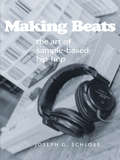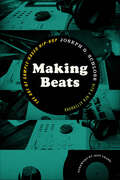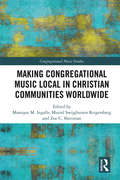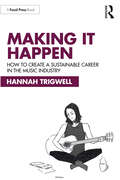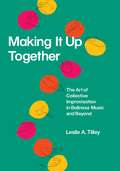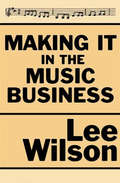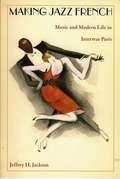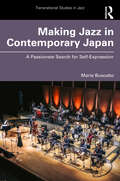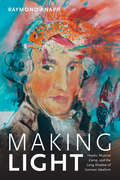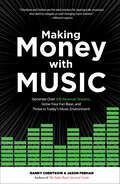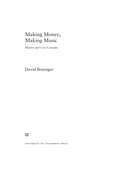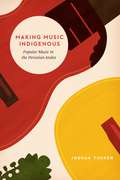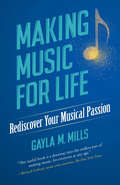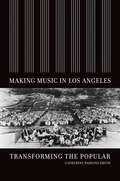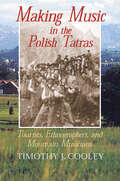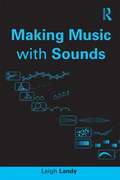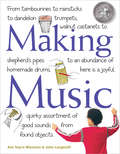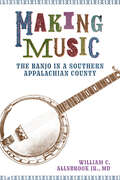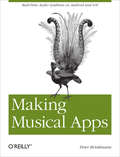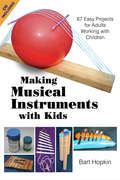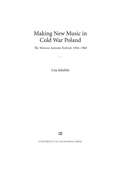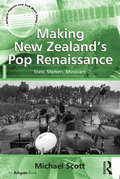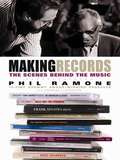- Table View
- List View
Making Beats
by Joseph G. SchlossDespite having created one of the most important musical cultures of the last fifty years, hip-hop composers who use digital sampling are rarely taken seriously as artists. But hip-hop deejays and producers have collectively developed an artistic system that features a complex aesthetic, a detailed array of social protocols, a rigorous set of ethical expectations and a rich historical consciousness. Based on ten years of research among hip-hop producers, Making Beats is the first work of scholarship to explore the goals, methods and values of this surprisingly insular community. Focusing on a variety of subjects--from hip-hop artists' pedagogical methods to the Afro-diasporic roots of the sampling process to the social significance of "digging" for rare records--Joseph G. Schloss examines the way hip-hop artists have managed to create a form of expression that reflects their creative aspirations, moral beliefs, political values and cultural realities.
Making Beats: The Art of Sample-Based Hip-Hop (Music Culture)
by Joseph G. SchlossWinner of IASPM's 2005 International Book AwardBased on ten years of research among hip-hop producers, Making Beats was the first work of scholarship to explore the goals, methods, and values of a surprisingly insular community. Focusing on a variety of subjects—from hip-hop artists' pedagogical methods to the Afrodiasporic roots of the sampling process to the social significance of "digging" for rare records—Joseph G. Schloss examines the way hip-hop artists have managed to create a form of expression that reflects their creative aspirations, moral beliefs, political values, and cultural realities. This second edition of the book includes a new foreword by Jeff Chang and a new afterword by the author.
Making Congregational Music Local in Christian Communities Worldwide (Congregational Music Studies Series)
by Zoe C. Sherinian Monique M. Ingalls Muriel Swijghuisen ReigersbergWhat does it mean for music to be considered local in contemporary Christian communities, and who shapes this meaning? Through what musical processes have religious beliefs and practices once ‘foreign’ become ‘indigenous’? How does using indigenous musical practices aid in the growth of local Christian religious practices and beliefs? How are musical constructions of the local intertwined with regional, national or transnational religious influences and cosmopolitanisms? Making Congregational Music Local in Christian Communities Worldwide explores the ways that congregational music-making is integral to how communities around the world understand what it means to be ‘local’ and ‘Christian’. Showing how locality is produced, negotiated, and performed through music-making, this book draws on case studies from every continent that integrate insights from anthropology, ethnomusicology, cultural geography, mission studies, and practical theology. Four sections explore a central aspect of the production of locality through congregational music-making, addressing the role of historical trends, cultural and political power, diverging values, and translocal influences in defining what it means to be ‘local’ and ‘Christian’. This book contends that examining musical processes of localization can lead scholars to new understandings of the meaning and power of Christian belief and practice.
Making It Happen: How to Create a Sustainable Career in the Music Industry
by Hannah TrigwellMaking It Happen is a comprehensive guide to navigating the modern music industry, that redefines what ‘making it’ means for musicians, and inspires and educates musicians on the different options for generating revenue from their art. This book offers theoretical and practical advice on making music, creating promotional content and embracing traditional and emerging social media platforms into your marketing strategies. Through interviews with music industry experts, readers can expect professional tips and advice, as well as clear instructions on how to build a dream team, make content, share that work and grow an audience to enable long-term business sustainability. In the modern music industry, having multiple revenue streams leads to a stable income. Making It Happen offers unique insights into the innovations and technologies available to contemporary music makers, making it essential reading for independent musicians, music business students, music producers and marketers.
Making It Up Together: The Art of Collective Improvisation in Balinese Music and Beyond (Chicago Studies in Ethnomusicology)
by Leslie A. TilleyMost studies of musical improvisation focus on individual musicians. But that is not the whole story. From jazz to flamenco, Shona mbira to Javanese gamelan, improvised practices thrive on group creativity, relying on the close interaction of multiple simultaneously improvising performers. In Making It Up Together, Leslie A. Tilley explores the practice of collective musical improvisation cross-culturally, making a case for placing collectivity at the center of improvisation discourse and advocating ethnographically informed music analysis as a powerful tool for investigating improvisational processes. Through two contrasting Balinese case studies—of the reyong gong chime’s melodic norot practice and the interlocking drumming tradition kendang arja—Tilley proposes and tests analytical frameworks for examining collectively improvised performance. At the micro-level, Tilley’s analyses offer insight into the note-by-note decisions of improvising performers; at the macro-level, they illuminate larger musical, discursive, structural, and cultural factors shaping those decisions. This multi-tiered inquiry reveals that unpacking how performers play and imagine as a collective is crucial to understanding improvisation and demonstrates how music analysis can elucidate these complex musical and interactional relationships. Highlighting connections with diverse genres from various music cultures, Tilley’s examinations of collective improvisation also suggest rich potential for cross-genre exploration. The surrounding discussions point to larger theories of communication and interaction, creativity and cognition that will be of interest to a range of readers—from ethnomusicologists and music theorists to cognitive psychologists, jazz studies scholars, and improvising performers. Setting new parameters for the study of improvisation, Making It Up Together opens up fresh possibilities for understanding the creative process, in music and beyond.
Making It Up Together: The Art of Collective Improvisation in Balinese Music and Beyond (Chicago Studies in Ethnomusicology)
by Leslie A. TilleyMost studies of musical improvisation focus on individual musicians. But that is not the whole story. From jazz to flamenco, Shona mbira to Javanese gamelan, improvised practices thrive on group creativity, relying on the close interaction of multiple simultaneously improvising performers. In Making It Up Together, Leslie A. Tilley explores the practice of collective musical improvisation cross-culturally, making a case for placing collectivity at the center of improvisation discourse and advocating ethnographically informed music analysis as a powerful tool for investigating improvisational processes. Through two contrasting Balinese case studies—of the reyong gong chime’s melodic norot practice and the interlocking drumming tradition kendang arja—Tilley proposes and tests analytical frameworks for examining collectively improvised performance. At the micro-level, Tilley’s analyses offer insight into the note-by-note decisions of improvising performers; at the macro-level, they illuminate larger musical, discursive, structural, and cultural factors shaping those decisions. This multi-tiered inquiry reveals that unpacking how performers play and imagine as a collective is crucial to understanding improvisation and demonstrates how music analysis can elucidate these complex musical and interactional relationships. Highlighting connections with diverse genres from various music cultures, Tilley’s examinations of collective improvisation also suggest rich potential for cross-genre exploration. The surrounding discussions point to larger theories of communication and interaction, creativity and cognition that will be of interest to a range of readers—from ethnomusicologists and music theorists to cognitive psychologists, jazz studies scholars, and improvising performers. Setting new parameters for the study of improvisation, Making It Up Together opens up fresh possibilities for understanding the creative process, in music and beyond.
Making It Up Together: The Art of Collective Improvisation in Balinese Music and Beyond (Chicago Studies in Ethnomusicology)
by Leslie A. TilleyMost studies of musical improvisation focus on individual musicians. But that is not the whole story. From jazz to flamenco, Shona mbira to Javanese gamelan, improvised practices thrive on group creativity, relying on the close interaction of multiple simultaneously improvising performers. In Making It Up Together, Leslie A. Tilley explores the practice of collective musical improvisation cross-culturally, making a case for placing collectivity at the center of improvisation discourse and advocating ethnographically informed music analysis as a powerful tool for investigating improvisational processes. Through two contrasting Balinese case studies—of the reyong gong chime’s melodic norot practice and the interlocking drumming tradition kendang arja—Tilley proposes and tests analytical frameworks for examining collectively improvised performance. At the micro-level, Tilley’s analyses offer insight into the note-by-note decisions of improvising performers; at the macro-level, they illuminate larger musical, discursive, structural, and cultural factors shaping those decisions. This multi-tiered inquiry reveals that unpacking how performers play and imagine as a collective is crucial to understanding improvisation and demonstrates how music analysis can elucidate these complex musical and interactional relationships. Highlighting connections with diverse genres from various music cultures, Tilley’s examinations of collective improvisation also suggest rich potential for cross-genre exploration. The surrounding discussions point to larger theories of communication and interaction, creativity and cognition that will be of interest to a range of readers—from ethnomusicologists and music theorists to cognitive psychologists, jazz studies scholars, and improvising performers. Setting new parameters for the study of improvisation, Making It Up Together opens up fresh possibilities for understanding the creative process, in music and beyond.
Making It in the Music Business: The Business and Legal Guide for Songwriters and Performers
by Lee WilsonFrom an experienced entertainment lawyer, &“a terrific handbook that outlines all the information a fledgling musician or songwriter needs to know&” (Booklist). Early in their careers, most musicians find it hard to believe that their band might ever make enough money to fight over. But sooner than you think, success may arrive, and without clear terms that spell out how the band is organized and who controls what rights, your best friends and fellow musicians may become your worst enemies. Anyone who seeks to enter the complex world of the music business ought to know what to do in order to avoid derailing a high-speed ride to the top of the charts. This guide from a longtime intellectual property lawyer can help you get there—without breaking up the band.
Making Jazz French: Music and Modern Life in Interwar Paris
by Jeffrey H. JacksonBetween the world wars, Paris welcomed not only a number of glamorous American expatriates, including Josephine Baker and F. Scott Fitzgerald, but also a dynamic musical style emerging in the United States: jazz. Roaring through cabarets, music halls, and dance clubs, the upbeat, syncopated rhythms of jazz soon added to the allure of Paris as a center of international nightlife and cutting-edge modern culture. In Making Jazz French, Jeffrey H. Jackson examines not only how and why jazz became so widely performed in Paris during the 1920s and 1930s but also why it was so controversial. Drawing on memoirs, press accounts, and cultural criticism, Jackson uses the history of jazz in Paris to illuminate the challenges confounding French national identity during the interwar years. As he explains, many French people initially regarded jazz as alien because of its associations with America and Africa. Some reveled in its explosive energy and the exoticism of its racial connotations, while others saw it as a dangerous reversal of France's most cherished notions of "civilization. " At the same time, many French musicians, though not threatened by jazz as a musical style, feared their jobs would vanish with the arrival of American performers. By the 1930s, however, a core group of French fans, critics, and musicians had incorporated jazz into the French entertainment tradition. Today it is an integral part of Parisian musical performance. In showing how jazz became French, Jackson reveals some of the ways a musical form created in the United States became an international phenomenon and acquired new meanings unique to the places where it was heard and performed.
Making Jazz in Contemporary Japan: A Passionate Search for Self-Expression (ISSN)
by Marie BuscattoMaking Jazz in Contemporary Japan: A Passionate Search for Self-Expression explores the ways in which Japanese jazz musicians express themselves through their art—not to “japanize” jazz, but to assert one’s creativity, passion, and capacity for self-expression—establishing it as an art form with its own sense of musicality and cultural, social, and economic concerns. This ethnographic survey contextualizes a shift in the Japanese jazz world over the last 30 years: What once was a culture dependent on the American influence is now a thriving local scene creating a wide variety of original, transnational compositions. Based on digital and physical observations and extensive interviews with nearly three dozen Japanese professional jazz musicians while featuring portraits of well-known artists, this empirical investigation into how, where, and why jazz is performed, opens doors to touch on culturally sensitive and taboo topics such as gender, sexuality, and indigenization. Suited for readers in global jazz studies and cultural study programs alike, this book is a timely sociological consideration of the Japanese jazz diaspora, a necessary update to break free of established tropes and clichés envisioning Japanese artists as mere imitators.
Making Light: Haydn, Musical Camp, and the Long Shadow of German Idealism
by Raymond KnappIn Making Light Raymond Knapp traces the musical legacy of German Idealism as it led to the declining prestige of composers such as Haydn while influencing the development of American popular music in the nineteenth century. Knapp identifies in Haydn and in early popular American musical cultures such as minstrelsy and operetta a strain of high camp—a mode of engagement that relishes both the superficial and serious aspects of an aesthetic experience—that runs antithetical to German Idealism's musical paradigms. By considering the disservice done to Haydn by German Idealism alongside the emergence of musical camp in American popular music, Knapp outlines a common ground: a humanistically based aesthetic of shared pleasure that points to ways in which camp receptive modes might rejuvenate the original appeal of Haydn's music that has mostly eluded audiences. In so doing, Knapp remaps the historiographical modes and systems of critical evaluation that dominate musicology while troubling the divide between serious and popular music.
Making Money with Music: Generate Over 100 Revenue Streams, Grow Your Fan Base, and Thrive in Today's Music Environment
by Jason Feehan Randy Chertkow“[Chertkow and Feehan] are the ideal mentors for aspiring indie musicians who want to navigate an ever-changing music industry.” —Billboard MagazineYou can make a living with music today. The secret is to tap multiple income streams.Making Money With Music gives you over 100 revenue streams and the knowledge on how to tap them. Whether you're a solo artist, band, DJ, EDM producer, or other musician, this book gives you strategies to generate revenue, grow your fan base, and thrive in today's technology-driven music environment. Plus, it lists hundreds of services, tools, and critical resources you need to run your business and maximize income.Making Money With Music will show you:How to tap over 100 income streams7 business strategies you can implement immediately How to start your music business for $0. How to register your music to collect all of the royalties you are owed worldwide. 13 ways to compete with free and build experiences to drive fan loyalty and engagement into everything you do to increase your revenue. 45 categories of places to get your music heard and videos seen so you can get discovered, grow your fanbase, generate royalties, and boost licensing opportunities. 10 methods for raising money so you can fund your music production and projects. ...and more.Written by the authors of the critically-acclaimed modern classic The Indie Band Survival Guide (1st & 2nd Editions), Making Money With Music is the third installment in The Indie Band Survival Guide series, and will help you build a sustainable music business no matter what kind of music you make, where you live, and whether you're a novice or professional musician. Improve your income by implementing these ideas for your music business today.
Making Money, Making Music: History and Core Concepts
by David BruengerMaking Money, Making Music offers tools to encourage creative and adaptive entrepreneurship in the music business. Written for the classroom and the workplace, it introduces readers to core principles and processes and shows how to apply them adaptively to new contexts, facilitating a deeper understanding of how and why things work in the music business. By applying essential concepts to a variety of real-life situations, readers improve their capacity to critically analyze and solve problems and to predict where music and money will converge in a rapidly evolving culture and marketplace.
Making Music Indigenous: Popular Music in the Peruvian Andes (Chicago Studies in Ethnomusicology)
by Joshua TuckerWhen thinking of indigenous music, many people may imagine acoustic instruments and pastoral settings far removed from the whirl of modern life. But, in contemporary Peru, indigenous chimaycha music has become a wildly popular genre that is even heard in the nightclubs of Lima. In Making Music Indigenous, Joshua Tucker traces the history of this music and its key performers over fifty years to show that there is no single way to “sound indigenous.” The musicians Tucker follows make indigenous culture and identity visible in contemporary society by establishing a cultural and political presence for Peru’s indigenous peoples through activism, artisanship, and performance. This musical representation of indigeneity not only helps shape contemporary culture, it also provides a lens through which to reflect on the country’s past. Tucker argues that by following the musicians that have championed chimaycha music in its many forms, we can trace shifting meanings of indigeneity—and indeed, uncover the ways it is constructed, transformed, and ultimately recreated through music.
Making Music for Life: Rediscover Your Musical Passion
by Gayla M. Mills"Making Music for Life is the adult novice's friend. First, it cheerleads for music's salutary benefits to the music-maker's soul. Then it becomes a useful how-to handbook: finding a teacher and learning how to practice once you have one. How do you hook up with like-minded enthusiasts and what are all the ways you can learn to make music together? How about performing for others? And maybe you will end up teaching others yourself. This useful book is a doorway into the endless joys of making music, for everyone at any age." — Bernard Holland, Music critic emeritus, The New York Times and author of Something I Heard Do you hope to expand your musical circle? Need inspiration and practical ideas for overcoming setbacks? Love music and seek new ways to enjoy it? Roots musician Gayla M. Mills will help you take your next step, whether you play jazz, roots, classical, or rock. You'll become a better musician, learning the best ways to practice, improve your singing, enjoy playing with others, get gigs and record, and bring more music to your community. Most importantly, you'll discover how music can help you live and age well. "A keen road map that supports musicians and the expansion of their craft. Gayla's done the work. All you have to do is step on the path and follow her lead." — Greg Papania, music producer, mixer, composer "Gayla Mills shares the nuts and bolts of fostering one's hidden musical talent. But perhaps most importantly, she shares the power behind music. . . . anyone seeking to awaken their musical passion will find this book ideal." — Dr. Lynn Szostek, psychologist and gerontologist "Making Music for Life absolutely fascinated me. It's beautifully written and engagingly constructed and it helped me better understand why music has remained central to my life. I found it entrancing." — Steve Yarbrough, author of The Unmade World and guitar player "Gayla Mills' precision with language, delight with music, and intrinsic joie de vivre make her the perfect author for Making Music for Life. Everyone who has tapped a foot or hummed along with a band will love this book, and maybe, just maybe, make music a bigger part of their lives." — Charlotte Morgan, author of Protecting Elvis "Gayla Mills shares the nuts and bolts of fostering one's hidden musical talent. But perhaps most importantly, she shares the power behind music. It boosts creativity and reduces stress. It strengthens social bonds, helping us find harmony while resonating with others. From amateur musician to Grammy-winning performer, anyone seeking to awaken their musical passion will find this book ideal." — Dr. Lynn Szostek, psychologist and gerontologist "What better way to counteract boredom, stress, anxiety and even depression than playfully learning a new instrument, singing, jamming, or just learning to hear the pitch, rhythm and timbres of sounds around you. Gayla Mills, in her book, Making Music for Life, offers tips for learning to hear and live life like a musician, while boosting your dopamine and improving cognition at the same time." — Dr. Jodie Skillicorn, psychiatrist "Gayla and I were part of a motley group of musicians who gathered monthly to play and sing. The years passed. My guitar strings rusted; my piano went out of tune. I felt remorse and sadness. But now I realize that I'm the perfect audience for this thoughtful, detailed book, and I'm very thankful she had the vision and heart to write it." — Liz Hodges, author and guitar/piano player "Music can be a powerful part of your life even if it is not your livelihood and Gayla's book Making Music for Life is like a table setting for this magical, mystical, musical table setting of love." — Michael Johnathon, musician and WoodSongs Old-time Radio Hour producer "As a scientist who frequently speaks about the benefits of music on the brain, I'm often asked: is it too late for me? Mills provides a highly readable and practical guide that democratizes music's promise." — Dr. Nina Kraus, Professor, Brainvolts Auditory Neuroscience Lab, Northwestern University
Making Music in Los Angeles: Transforming the Popular
by Catherine Parsons SmithIn this social history of music in Los Angeles from the 1880s to 1940, Catherine Parsons Smith ventures into an often neglected period to discover that during America's Progressive Era, L.A. was a center for making music long before it became a major metropolis. She describes the thriving music scene over some sixty years, including opera, concert giving and promotion, and the struggles of individuals who pursued music as an ideal, a career, a trade, a business--or all those things at once.
Making Music in the Polish Tatras: Tourists, Ethnographers, and Mountain Musicians
by Timothy J. CooleyChallenging myths that mountain isolation and ancient folk customs defined the music culture of the Polish Tatras, Timothy J. Cooley shows that intensive contact with tourists and their more academic kin, ethnographers, since the late 19th century helped shape both the ethnic group known as Górale (highlanders) and the music that they perform. Making Music in the Polish Tatras reveals how the historically related practices of tourism and ethnography actually created the very objects of tourist and ethnographic interest in what has become the popular resort region of Zakopane. This lively book introduces readers to Górale musicians, their present-day lives and music making, and how they navigate a regional mountain-defined identity while participating in global music culture. Vivid descriptions of musical performances at weddings, funerals, and festivals and the collaboration of Górale fiddlers with the Jamaican reggae group Twinkle Brothers are framed by discussions of currently influential theories relating to identity and ethnicity and to anthropological and sociological studies of ritual, tourism, festivals, globalism, and globalization. The book includes a 46-track CD illustrating the rich variety of Górale music, including examples of its fusion with Jamaican reggae.
Making Music with Sounds
by Leigh LandyMaking Music with Sounds offers a creative introduction to the art of making sound-based music. It introduces the elements of making compositions with sounds and facilitates creativity in school age children, with the activities primarily for 11-14 year old students. It can also be used by people of all ages becoming acquainted with this music for the first time. Sound-based music is defined as the art form in which the sound, rather than the musical note, is the basic unit and is closely related to electronic music and the sonic arts. The art of sound organisation can be found in a number of forms of music--in film, television, theatre, dance, and new media. Despite this, there are few materials available currently for young people to discover how to make sound-based music. This book offers a programme of development starting from aural awareness, through the discovery and organisation of potential sounds, to the means of generating and manipulating sounds to create sequences and entire works. The book’s holistic pedagogical approach to composition also involves aspects related to musical understanding and appreciation, reinforced by the author’s online pedagogical ElectroAcoustic Resource Site (EARS II).
Making Music: From Tambourines to Rainsticks to Dandelion Trumpets, Walnut Castanets to Shepherd's Pipes to an Abundance of Homemade Drums, Here Is a Joyful, Quirky Assortment of Good Sounds from Found Objects
by John Langstaff Ann Sayre WisemanTune up a milk carton guitar and get ready for a kitchen concerto in the key of utensils major! Ann Sayre Wiseman and John Langstaff offer dozens of ideas that encourage children to unlock their musical creativity using everyday objects. Kids will be inspired as they turn a shower hose into a trumpet or pair zippers and Velcro to make their own percussion ensemble. With ideas for creating and playing more than 70 basic rhythm, string, wind, and keyboard instruments, the musical possibilities are endless.
Making Music: The Banjo in a Southern Appalachian County (American Made Music Series)
by William C. Allsbrook Jr.The banjo has been emblematic of the Southern Appalachian Mountains since the late twentieth century. Making Music: The Banjo in a Southern Appalachian County takes a close look at the instrument and banjo players in Haywood County, North Carolina. Author William C. Allsbrook Jr., MD, presents the oral histories of thirty-two banjo players, all but two of whom were born in Haywood County. These talented musicians recount, in their own words, their earliest memories of music, and of the banjo, as well as the appeal of the banjo. They also discuss learning to play the instrument, including what it “feels like” playing the banjo, many describing occasional “flow states.”In the book, Allsbrook explores an in-home musical folkway that developed along the colonial frontier. By the mid-1800s, frontier expansion had ceased in Haywood County due to geographic barriers, but the in-home musical tradition, including the banjo, survived in largely isolated areas. Vestiges of that tradition remain to this day, although the region has undergone significant changes over the lifetimes of the musicians interviewed. As a result, the survival of the in-home tradition is not guaranteed. Readers are invited into the private lives of the banjo players and asked to consider the future of the banjo in the face of contemporary trends. The future will be shaped by how this remarkable mountain culture continues to adapt to these challenges. Still, this thriving community of banjo players represents the vibrant legacy of the banjo in Haywood County and the persistence of tradition in the twenty-first century.
Making Musical Apps: Real-time audio synthesis on Android and iOS
by Peter BrinkmannWant to turn your mobile device into a musical instrument? Or equip your game with interactive audio, rather than canned samples? You can do it with Pure Data (Pd), an open source visual programming environment that lets you manipulate digital audio in real time. This concise book shows you how to use Pd—with help from the libpd library—as an easily embeddable and widely portable sound engine.Whether you’re an audio developer looking to create musical apps with sophisticated audio capabilities, or an application developer ready to enhance mobile games with real-time procedural audio, Making Musical Apps introduces you to Pd and libpd, and provides hands-on instructions for creating musical apps for Android and iOS.Get a crash course in Pd, and discover how to generate and control soundsLearn how to create and deploy algorithmic compositions that react to a user’s activity and environmentUse Java or Objective-C to integrate Pd and libpd into mobile appsLearn the steps necessary to build libpd-based apps for Android and iOS
Making Musical Instruments with Kids: 67 Easy Projects for Adults Working with Children
by Bart HopkinWritten for adults, this hands-on guide demonstrates how to make easy musical instruments with children. Detailed instructions are included for making more than 60 unique instruments that are suitable for children as young as five years. Serving as a resource in the classroom or home, this manual is extensively illustrated with drawings and photographs along with an audio sample of the instruments in lively solo and ensemble pieces.
Making New Music in Cold War Poland: The Warsaw Autumn Festival, 1956-1968
by Lisa JakelskiMaking New Music in Cold War Poland presents a social analysis of new music dissemination at the Warsaw Autumn International Festival of Contemporary Music, one of the most important venues for East-West cultural contact during the Cold War. In this incisive study, Lisa Jakelski examines the festival's institutional organization, negotiations among its various actors, and its reception in Poland, while also considering the festival's worldwide ramifications, particularly the ways that it contributed to the cross-border movement of ideas, objects, and people (including composers, performers, official festival guests, and tourists). This book explores social interactions within institutional frameworks and how these interactions shaped the practices, values, and concepts associated with new music.
Making New Zealand's Pop Renaissance: State, Markets, Musicians (Ashgate Popular and Folk Music Series)
by Michael ScottSince the early 2000s New Zealand has undergone a pop renaissance. Domestic artists' sales, airplay and concert attendance have all grown dramatically while new avenues for 'kiwi' pop exports emerged. Concurrent with these trends was a new collective sentiment that embraced and celebrated domestic musicians. In Making New Zealand's Pop Renaissance, Michael Scott argues that this revival arose from state policies and shows how the state built market opportunities for popular musicians through public-private partnerships and organizational affinity with existing music industry institutions. New Zealand offers an instructive case for the ways in which 'after neo-liberal' states steer and co-ordinate popular culture into market exchange by incentivizing cultural production. Scott highlights how these music policies were intended to address various economic and social problems. Arriving with the creative industries' discourse and policy making, politicians claimed these expanded popular music supports would facilitate sustainable employment and a sense of national identity. Yet popular music as economic and social policy presents a paradox: the music industry generates commercial failure and thus requires a large unattached pool of potential talent. Considering this feature, Scott analyses how state programs induced an informal economy of proto-pop production aimed at accessing competitive state funding while simultaneously encouraging musicians to adopt entrepreneurial subjectivities. In doing so he argues New Zealand's music policies are a form of social policy that unintentionally deploy hierarchical structures to foster social inclusion amongst growing numbers of creative workers.
Making Records: The Scenes Behind the Music
by Phil RamoneSinatra. Streisand. Dylan. Pavarotti. McCartney. Sting. Madonna. What do these musicians have in common besides their super-stardom? They have all worked with legendary music producer Phil Ramone.For almost five decades, Phil Ramone has been a force in the music industry. He has produced records and collaborated with almost every major talent in the business. There is a craft to making records, and Phil has spent his life mastering it. For the first time ever, he shares the secrets of his trade.Making Records is a fascinating look "behind the glass" of a recording studio. From Phil's exhilarating early days recording jazz and commercial jingles at A&R, to his first studio, and eventual legendary producer status, Phil allows you to sit in on the sessions that created some of the most memorable music of the 20th century--including Frank Sinatra's Duets album, Bob Dylan's Blood on the Tracks, Ray Charles's Genius Loves Company and Paul Simon's Still Crazy After All These Years.In addition to being a ringside seat for contemporary popular music history, Making Records is an unprecedented tutorial on the magic behind what music producers and engineers do. In these pages, Phil offers a rare peek inside the way music is made . . . illuminating the creative thought processes behind some of the most influential sessions in music history.This is a book about the art that is making records--the way it began, the way it is now, and everything in between.
